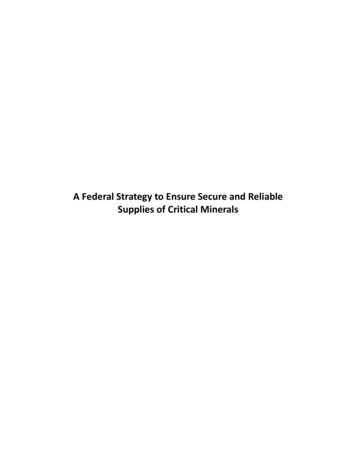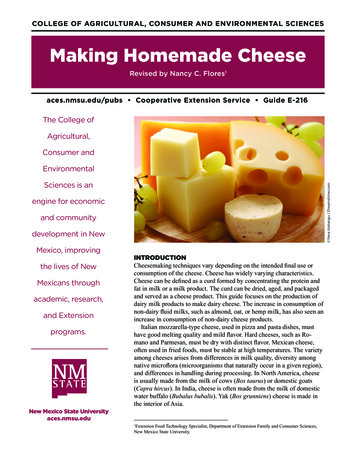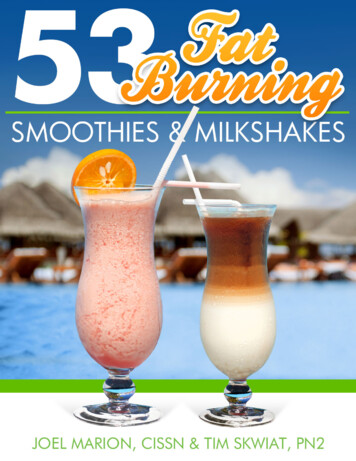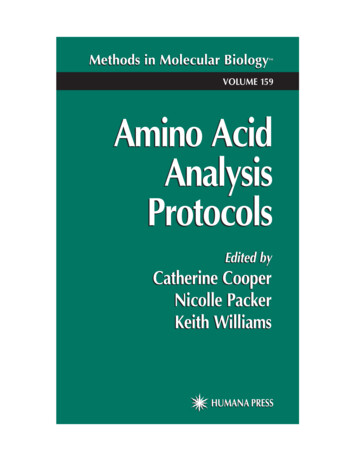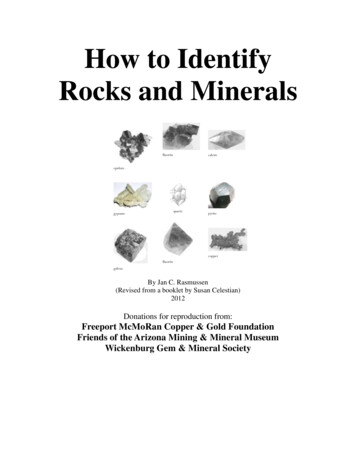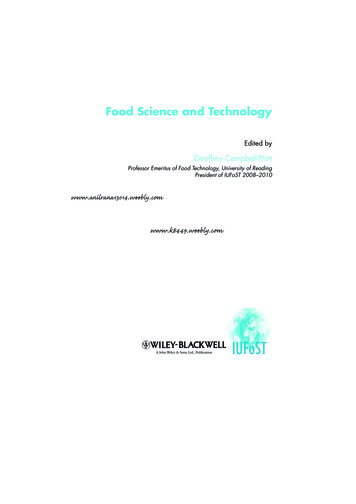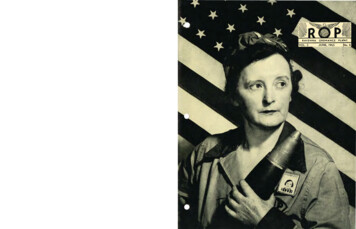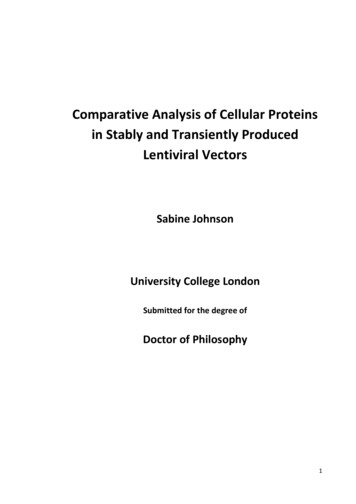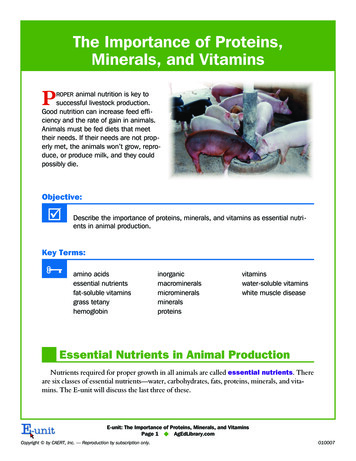
Transcription
The Importance of Proteins,Minerals, and VitaminsPROPER animal nutrition is key tosuccessful livestock production.Good nutrition can increase feed efficiency and the rate of gain in animals.Animals must be fed diets that meettheir needs. If their needs are not properly met, the animals won’t grow, reproduce, or produce milk, and they couldpossibly die.Objective:þDescribe the importance of proteins, minerals, and vitamins as essential nutrients in animal production.Key Terms:Ñamino acidsessential nutrientsfat-soluble vitaminsgrass smineralsproteinsvitaminswater-soluble vitaminswhite muscle diseaseEssential Nutrients in Animal ProductionNutrients required for proper growth in all animals are called essential nutrients. Thereare six classes of essential nutrients—water, carbohydrates, fats, proteins, minerals, and vitamins. The E-unit will discuss the last three of these.E-unit: The Importance of Proteins, Minerals, and VitaminsPage 1 u AgEdLibrary.comCopyright by CAERT, Inc. — Reproduction by subscription only.010007
PROTEINSProteins are organic compounds that contain carbon, hydrogen, oxygen, and nitrogen andsometimes iron, phosphorus, and sulfur. They are needed to grow new tissues and to repairold tissues in an animal. Every day, 3 to 5 percent of the body’s proteins are rebuilt. The highest amounts of proteins can be found in the muscles of animals.The most common nutrient deficiency is that of proteins. Since most feedstuffs are low inproteins, protein supplements may be necessary. Sources of proteins include soybean meal,cottonseed meal, fish meal, and legume hay. Symptoms of a protein deficiency includeanorexia, slow growth rate, decreased feed efficiency, low birth weight, and lower milk production. Proteins are important for weight gain, growth, and gestation. Young animals needdiets higher in proteins than older animals. Animals in gestation or lactation stages also needhigher levels of proteins in their diets.Proteins are made up of various combinations of up to 26 amino acids. Amino acids arethe building blocks of proteins. Amino acids are classified as either essential or nonessential.Most animals can synthesize the nonessential amino acids. However, the essential aminoacids must be supplied in the diets of nonruminant animals. Monogastric animals are unable tosynthesize amino acids and thus should have their diets supplemented with proteins containing the 10 essential amino acids. The essential amino acids are arginine, histidine, isoleucine,leucine, lysine, methionine, phenylalanine, threonine, tryptophan, and valine. Ruminants arecapable of synthesizing all amino acids by microbial action in the rumen.MINERALSMinerals are inorganic elements found in small amounts in the body. Inorganic meansthat the substance does not contain carbon.To prevent mineral deficiencies, minerals are included in livestock feed rations and are provided through free access tomineral and salt blocks. Mineraldeficiencies can result in poorweight gain, poor feed efficiency,and poor reproductive traits.Minerals are classified asmacrominerals or microminerals.MacromineralsMacrominerals are mineralsneeded in the diet in relativelylarge amounts. Requirements canrange from a few tenths of a gramFIGURE 1. Mineral blocks are provided for grazing animals to lick so thenecessary minerals can be obtained.E-unit: The Importance of Proteins, Minerals, and VitaminsPage 2 u AgEdLibrary.comCopyright by CAERT, Inc. — Reproduction by subscription only.010007
to one or more grams per day. Macrominerals include calcium, chlorine, magnesium, phosphorus, potassium, sodium, and sulfur.Calcium and phosphorus are needed in a certain ratio for bone growth and repair and forother body functions. Magnesium is needed for chemical reactions in muscles and for skeletalgrowth. Grass tetany, a potentially deadly condition that occurs in lactating cows on springpastures, is a result of magnesium deficiency. Potassium aids in the uptake of glucose. Sodiumand chlorine are provided by salt (NaCl) and are necessary to maintain water balance and toprovide sources of iodine. Sulfur is required for protein synthesis.MicromineralsMicrominerals, or trace minerals, are minerals required in small quantities. These minerals are just as important as macrominerals; they are just needed in smaller amounts. Requirements can range from a millionth of a gram to a thousandth of a gram per day.Microminerals include chromium, cobalt, copper, fluorine, iodine, iron, manganese,molybdenum, selenium, and zinc. Chromium activates certain enzymes involved in the production of energy. Cobalt is a part of the molecule of vitamin B12. Copper is necessary for normal iron absorption. Fluorine promotes sound bones and teeth. Iodine is needed by the thyroid gland in the synthesis of the hormone thyroxine. Iron is required for the production ofhemoglobin. Hemoglobin is a protein in the red blood cells that transports oxygen to tissuesand carbon dioxide from tissues. Manganese plays an important part in the formation of boneand in blood clotting. Molybdenum serves many purposes and is part of tooth enamel. Selenium, along with vitamin E, helps to prevent white muscle disease. White muscle diseaseis a potentially deadly condition in young calves that is a result of a selenium deficiency. Zinc,in proper amounts, has a major effect on bones, skin, hair, and feathers.VITAMINSVitamins are organic nutrients needed in small quantities to perform specific functions.They do not provide energy but are necessary in the use of energy. Vitamins aid an animal byhelping regulate body functions, keeping the body healthy, and promoting resistance to diseases. The deficiency of a vitamin can lead to disease or death. Vitamins are classified as fat soluble and water soluble.Fat-Soluble VitaminsFat-soluble vitamins are vitamins stored in the fat and released as they are needed by thebody. Fat-soluble vitamins can be stored for extended periods. They include vitamins A, D, E,and K.Vitamin A helps maintain internal and external linings and is necessary for a healthy reproductive tract. Vitamin A is not readily available in most feeds. A lack of Vitamin A affects theeyes. Carotene is a precursor of vitamin A. Carotene is found in plants; the body transforms itinto vitamin A. The amount of vitamin A in a roughage is typically indicated by the degree ofE-unit: The Importance of Proteins, Minerals, and VitaminsPage 3 u AgEdLibrary.comCopyright by CAERT, Inc. — Reproduction by subscription only.010007
greenness. Vitamin A deficiency is the most common deficiency in cattle. Signs of a vitamin Adeficiency include watery eyes, a rough hair coat, and a reduced growth rate.Vitamin D regulates the absorption of calcium and phosphorus. Animals make their ownvitamin D when exposed to sunlight.Vitamin E promotes good health. A lack of vitamin E causes failure in the reproductive system. Alfalfa is a good source of vitamin E.Vitamin K is important in blood clotting. Vitamin K is typically not necessary in the diet, asbacteria in the digestive system produce it.Water-Soluble VitaminsWater-soluble vitamins are vitamins dissolved by water. As water passes through thebody, it carries out water-soluble vitamins. Thus, these vitamins need to be consumed everyday by monogastric animals. Water-soluble vitamins are made by microorganisms in therumen of a ruminant animal and by fermentation in the cecum of the horse. Water-solublevitamins include Vitamin C and the B vitamins.Vitamin C is synthesized in animal tissues. Therefore, it is not necessary to add it to feedrations.B vitamins are classified into two groups. Group I B vitamins include thiamin, riboflavin,niacin, and pantothenic acid. Group I B vitamins are involved in the release of energy fromfeed nutrients. Group II B vitamins include folic acid and vitamin B12. Group II B vitaminscontrol the formation of red blood cells.Summary:2There are six classes of essential nutrients—water, carbohydrates, fats, proteins,minerals, and vitamins. Proteins, minerals, and vitamins were discussed in this Eunit. An animal needs proteins to grow new tissue and repair old tissue. Proteindeficiency is the most common nutrient deficiency. Thus, proteins are typicallysupplemented in the diet. Sources of proteins include soybean meal and legumehay. A mineral is an inorganic element found in small amounts in the body. Minerals can be classified as macrominerals or microminerals. Vitamins are organic nutrients needed in small quantities to perform specific functions. Vitamins are classifiedas fat soluble or water soluble.Checking Your Knowledge: 1. Name the six classes of essential nutrients.2. Describe the function of proteins.3. Name two sources of proteins.4. List two symptoms of protein deficiency.E-unit: The Importance of Proteins, Minerals, and VitaminsPage 4 u AgEdLibrary.comCopyright by CAERT, Inc. — Reproduction by subscription only.010007
5. List the 10 essential amino acids.6. Name the seven macrominerals.7. Describe the function of calcium and phosphorus.8. What is the typical source of sodium and chlorine?9. Name the 10 microminerals.10. Name three symptoms of a mineral deficiency.11. Name the four fat-soluble vitamins.12. What is the function of vitamin D?Expanding Your Knowledge:LAnalyze the nutritional information on a bag of livestock or pet food. What are themajor ingredients? What is the percent protein? Which minerals does the food contain, and how much of each mineral is present? Which vitamins does the food contain, and how much of each vitamin is present?Web Links::Nutrition and Feeding of the Cow-Calf 1.htmlNecessary Nutrients for ents.aspxProtein Requirements for Good Cat ls 1&cat 1399&articleid 701Nutrition for the unit: The Importance of Proteins, Minerals, and VitaminsPage 5 u AgEdLibrary.comCopyright by CAERT, Inc. — Reproduction by subscription only.010007
Mar 14, 2011 · greenness. Vitamin A deficiency is the most common deficiency in cattle. Signs of a vitamin A deficiency include w


